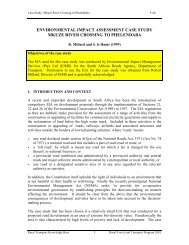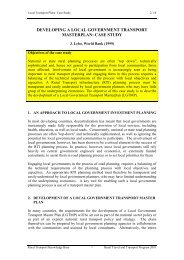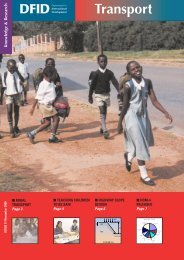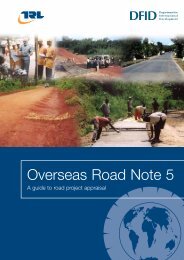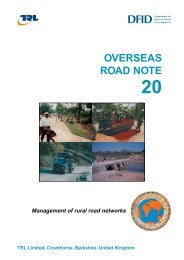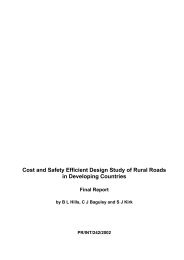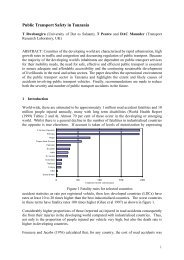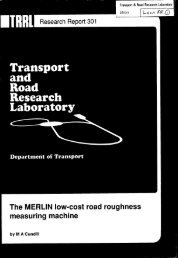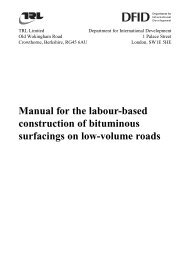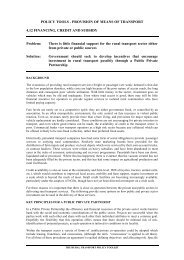A guideline for low-volume sealed roads in the SADC region . First ...
A guideline for low-volume sealed roads in the SADC region . First ...
A guideline for low-volume sealed roads in the SADC region . First ...
Create successful ePaper yourself
Turn your PDF publications into a flip-book with our unique Google optimized e-Paper software.
c) Promote and implement new approaches, recent knowledge, <strong>in</strong>novative technologiesand greater local <strong>in</strong>volvement <strong>in</strong> <strong>the</strong> provision of <strong>the</strong>se <strong>roads</strong>.d) Produce a <strong>guidel<strong>in</strong>e</strong> with <strong>the</strong> full participation of <strong>region</strong>al experts from <strong>the</strong> public andprivate sectors <strong>in</strong> <strong>the</strong> <strong>region</strong>.e) Produce <strong>the</strong> document through SATCC to ensure <strong>region</strong>al ownership andendorsement by <strong>the</strong> member states of <strong>SADC</strong>.6. PROJECT METHODOLOGYLocal stakeholder participation <strong>in</strong> all aspects of <strong>the</strong> provision of <strong>in</strong>frastructure and transportservices <strong>in</strong>creases awareness of <strong>the</strong> benefits of appropriate technical solutions and reducesperceived risks.The pr<strong>in</strong>cipal aim of <strong>the</strong> project is to maximise <strong>the</strong> implementation of previous research anddevelopment and <strong>the</strong>re<strong>for</strong>e dissem<strong>in</strong>ation and promotion is <strong>the</strong> heart of <strong>the</strong> project. It is nowaccepted that substantial local <strong>in</strong>volvement <strong>in</strong> projects is essential <strong>for</strong> susta<strong>in</strong>ability and methodsof <strong>in</strong>creas<strong>in</strong>g <strong>the</strong> participation of <strong>in</strong>digenous professionals from <strong>the</strong> public and private sectorsare <strong>in</strong>cluded <strong>in</strong> both <strong>the</strong> project itself and <strong>in</strong> <strong>the</strong> published <strong>guidel<strong>in</strong>e</strong>s. It is <strong>the</strong>re<strong>for</strong>e a key aspectof <strong>the</strong> project design that most of <strong>the</strong> tasks will be carried out by teams of professionals fromthroughout <strong>the</strong> <strong>region</strong>, draw<strong>in</strong>g on local experiences as well as <strong>the</strong> outputs of <strong>the</strong> <strong>in</strong>ternationalresearch ef<strong>for</strong>t. There<strong>for</strong>e, <strong>the</strong>re will be a much higher level of "local" participation <strong>in</strong> <strong>the</strong>compilation of <strong>the</strong> <strong>guidel<strong>in</strong>e</strong> than has been usual <strong>in</strong> many previous documents of this type. Thiswill ensure that local knowledge is <strong>in</strong>corporated <strong>in</strong> <strong>the</strong> document and that <strong>the</strong> <strong>guidel<strong>in</strong>e</strong> will be alocal product reflect<strong>in</strong>g <strong>the</strong> needs of <strong>the</strong> <strong>region</strong>. This is particularly important <strong>in</strong> <strong>the</strong> compilationof application manuals and <strong>guidel<strong>in</strong>e</strong> documents. Thus, <strong>in</strong> order to have <strong>the</strong> maximum impact; itis essential that <strong>the</strong> local eng<strong>in</strong>eer<strong>in</strong>g community play a full part <strong>in</strong> develop<strong>in</strong>g <strong>the</strong> manual.Task groups will be established which will <strong>in</strong>clude government specialists, consultants andresearchers who are considered experts <strong>in</strong> <strong>the</strong>ir fields. Each task group will review <strong>the</strong><strong>in</strong><strong>for</strong>mation available and present <strong>the</strong> <strong>in</strong><strong>for</strong>mation available to <strong>the</strong> workshop. O<strong>the</strong>r technicalpapers will also be presented. The <strong>guidel<strong>in</strong>e</strong> chapters will be subjected to peer review. Thef<strong>in</strong>al draft document will be presented at a sem<strong>in</strong>ar and <strong>the</strong> f<strong>in</strong>al document prepared <strong>for</strong>publication through SATCC-TU.The <strong>guidel<strong>in</strong>e</strong> will <strong>in</strong>clude state-of-<strong>the</strong>-art <strong>in</strong><strong>for</strong>mation on <strong>the</strong> fol<strong>low</strong><strong>in</strong>g aspects of <strong>low</strong>-<strong>volume</strong><strong>sealed</strong> road provision• Plann<strong>in</strong>g and economic appraisal• Geometric design• Pavement design and surfac<strong>in</strong>g• Construction methods (<strong>in</strong>clud<strong>in</strong>g labour-based methods) and dra<strong>in</strong>age• Ma<strong>in</strong>tenance• Environment• Road safetyIn each of <strong>the</strong>se areas <strong>the</strong>re have been developments <strong>in</strong> recent years, which impact on <strong>the</strong>provision of <strong>low</strong>-<strong>volume</strong> surfaced <strong>roads</strong> <strong>in</strong> <strong>the</strong> <strong>region</strong>. Many of <strong>the</strong>se developments areunpublished but <strong>the</strong> professionals <strong>in</strong>volved <strong>in</strong> <strong>the</strong> provision of <strong>low</strong>-<strong>volume</strong> <strong>sealed</strong> <strong>roads</strong> alsoseem to ignore or, <strong>for</strong> some reason, are unable to apply even those that are published.7. PROJECT MANAGEMENTThe project is managed by <strong>the</strong> Transport Research Laboratory TRL) based <strong>in</strong> Harare,4
Zimbabwe under a contract with SATCC-TU. The Norwegian Prov<strong>in</strong>cial RoadsAdm<strong>in</strong>istration (NPRA) is <strong>the</strong> named co-manager provid<strong>in</strong>g specific <strong>in</strong>puts on <strong>the</strong> technicalmanagement and co-ord<strong>in</strong>ation of <strong>the</strong> project under a sub-contract agreement with TRL.8. PROGRAMThe project started <strong>in</strong> May 2000 and it is due <strong>for</strong> completion by April 2002.The outl<strong>in</strong>e methodology <strong>in</strong>cludes a series of workshops to be held throughout <strong>the</strong> <strong>SADC</strong><strong>region</strong>, <strong>in</strong> which <strong>the</strong> contents of <strong>the</strong> appropriate chapter of <strong>the</strong> <strong>guidel<strong>in</strong>e</strong> are discussed. Each of<strong>the</strong> <strong>SADC</strong> member states is <strong>in</strong>vited to send a delegate, who can contribute to <strong>the</strong> technicalcontent of <strong>the</strong> chapter and represent <strong>the</strong> views of <strong>the</strong> country that is represented.O<strong>the</strong>r key stakeholders <strong>in</strong> <strong>the</strong> project are representatives from <strong>the</strong> private sector, who areexpected to play a major role both <strong>in</strong> <strong>the</strong> compilation of <strong>the</strong> <strong>guidel<strong>in</strong>e</strong> and <strong>in</strong> <strong>the</strong> implementationof <strong>the</strong> <strong>guidel<strong>in</strong>e</strong> recommendations. Consultants have been provisionally identified who areconsidered competent to make a significant contribution to <strong>the</strong> technical contents of <strong>the</strong>chapters of <strong>the</strong> report. These <strong>in</strong>clude local and <strong>region</strong>al consultants based with<strong>in</strong> <strong>the</strong> <strong>SADC</strong>member states as well as <strong>in</strong>ternational consultants and researchers who are considered to beexperts <strong>in</strong> <strong>the</strong>ir fields and who are familiar with <strong>the</strong> problems associated with road provision <strong>in</strong><strong>the</strong> <strong>region</strong>.It is recognised that much <strong>in</strong>novative work is often carried out <strong>in</strong> <strong>in</strong>-house country programmes<strong>in</strong> order to solve particular problems. Often, <strong>the</strong> results of this work are not published and o<strong>the</strong>rcountries <strong>in</strong> <strong>the</strong> <strong>region</strong> are <strong>the</strong>n unaware of options and solutions, which may be alsoappropriate <strong>for</strong> <strong>the</strong>m too. It is important that such projects are identified and <strong>the</strong> results andrecommendations <strong>in</strong>cluded <strong>in</strong> <strong>the</strong> document, as <strong>the</strong>y may be particularly relevant <strong>in</strong> <strong>the</strong> contextof this <strong>region</strong>al <strong>guidel<strong>in</strong>e</strong>.The importance of SATCC-TU <strong>in</strong> provid<strong>in</strong>g technical and strategic advice <strong>in</strong> <strong>the</strong> project is alsorecognised. As <strong>the</strong> organisation responsible <strong>for</strong> <strong>the</strong> harmonisation of standards <strong>for</strong> <strong>the</strong> trunkroad network and <strong>for</strong> develop<strong>in</strong>g recommendations <strong>for</strong> <strong>the</strong> implementation of appropriatestandards on o<strong>the</strong>r <strong>roads</strong>, its role is pivotal to <strong>the</strong> production of <strong>the</strong> <strong>guidel<strong>in</strong>e</strong>, dissem<strong>in</strong>ation of<strong>the</strong> document and implementation.9. COLLATION OF INFORMATIONIt is <strong>the</strong> <strong>in</strong>tention that this document will conta<strong>in</strong> as much <strong>in</strong><strong>for</strong>mation as possible on <strong>the</strong> resultsof research, practices, methodologies, techniques, which have been developed <strong>in</strong> <strong>the</strong> <strong>region</strong>and <strong>for</strong> <strong>the</strong> <strong>region</strong>. The aim is to raise awareness of <strong>the</strong>se developments so that practitionersand fund<strong>in</strong>g agencies <strong>in</strong> <strong>the</strong> road sector have a greater level of choice <strong>in</strong> decid<strong>in</strong>g what is mostappropriate <strong>in</strong> <strong>the</strong>ir respective field of expertise <strong>in</strong> road provision. Part of <strong>the</strong> role of all <strong>the</strong>participants <strong>in</strong> this project is to provide <strong>in</strong><strong>for</strong>mation <strong>for</strong> <strong>the</strong> relevant chapter to <strong>the</strong> lead authorand this is a key cont<strong>in</strong>uous activity <strong>in</strong> <strong>the</strong> project.5
A significant outcome from <strong>the</strong> workshops is <strong>the</strong> amount of <strong>in</strong><strong>for</strong>mation on <strong>in</strong>novative practicesdescribed by <strong>the</strong> country delegates <strong>in</strong> <strong>the</strong>ir presentations and <strong>the</strong> workshop discussions. Muchof <strong>the</strong> <strong>in</strong><strong>for</strong>mation is unpublished. It is <strong>the</strong> role of <strong>the</strong> lead authors to collate this <strong>in</strong><strong>for</strong>mation with<strong>the</strong> assistance of <strong>the</strong> o<strong>the</strong>r workshop participants.13. WORKSHOP REPORTSReports are currently available <strong>for</strong> <strong>the</strong> first two workshops and <strong>the</strong> ma<strong>in</strong> issues discussedand outcomes are as fol<strong>low</strong>s.Workshop No 1. (Overview and Road ma<strong>in</strong>tenance)The workshop aimed to provide participants with a comprehensive appreciation of <strong>the</strong>overall concept and background to <strong>the</strong> <strong>guidel<strong>in</strong>e</strong>, and to seek <strong>the</strong>ir <strong>in</strong>put to <strong>the</strong>implementation of <strong>the</strong> project, <strong>the</strong> scope and focus of <strong>the</strong> <strong>guidel<strong>in</strong>e</strong> and <strong>the</strong> issues to beaddressed <strong>in</strong> <strong>the</strong> chapter on ‘Ma<strong>in</strong>tenance’.23 participants drawn from 15 countries attended <strong>the</strong> first 5-day workshop held <strong>in</strong> Harare,Zimbabwe between <strong>the</strong> 13 th and 17 th November 2000.The workshop <strong>for</strong>mat <strong>in</strong>volved <strong>in</strong>troductions and summ<strong>in</strong>g up, presentations led by <strong>the</strong>Project Team, 8 workshop tasks and feedback sessions and 14 participant presentations.Participatory activities occupied <strong>in</strong> excess of 60% of <strong>the</strong> workshop programme.A set of 8 Outcomes and Actions cover<strong>in</strong>g <strong>the</strong> fol<strong>low</strong><strong>in</strong>g issues were agreed:• Increas<strong>in</strong>g <strong>the</strong> Adoption of Appropriate Cost Effective Standards• Importance of Effective In-Country Organisation• Importance of In country Standards Development• Regional and International Co-ord<strong>in</strong>ation• Project Strategy• Format and Structure of <strong>the</strong> Guidel<strong>in</strong>es• Proposed Companion Document• Draft Table of Contents of Ma<strong>in</strong>tenance ChapterIn addition, <strong>the</strong> workshop generated <strong>the</strong> fol<strong>low</strong><strong>in</strong>g valuable <strong>in</strong><strong>for</strong>mation and <strong>in</strong>sights:a) 39 case studies relat<strong>in</strong>g to relevant and often <strong>in</strong>novative experience (<strong>the</strong> ‘Gems’) wereoffered by <strong>the</strong> Group;b) Analysis of barriers to <strong>the</strong> implementation of appropriate, cost effective standardsidentified ‘Fear of Change’ and perceived ‘Risk’ as major factors <strong>in</strong> <strong>the</strong> lack ofwidespread adoption of new techniques;c) Lack of Ownership and User Acceptance’ and ‘Lack of Capacity and Funds’ toeffectively participate <strong>in</strong> technology development programmes were also ranked highlyas obstacles to change;d) Solutions mirrored <strong>the</strong> problems and emphasised <strong>the</strong> need to develop broad stakeholderownership through participation and effective dissem<strong>in</strong>ation.Workshop No 2 (Construction Methods and Dra<strong>in</strong>age)The second 5 day workshop on Pavement Design and Surfac<strong>in</strong>g was held <strong>in</strong> Dar es Salaam,Tanzania, from 22 – 26 January, 2001 and was attended by participants from national <strong>roads</strong>agencies <strong>in</strong> 10 <strong>SADC</strong> countries.The ma<strong>in</strong> objective of <strong>the</strong> workshop was to <strong>in</strong>volve a cross-section of practitioners from <strong>the</strong><strong>region</strong> <strong>in</strong> <strong>the</strong> critical review and discussion of a range of factors that affect <strong>the</strong> pavement7
design and surfac<strong>in</strong>g of <strong>low</strong> <strong>volume</strong> <strong>sealed</strong> <strong>roads</strong>. The f<strong>in</strong>al output of <strong>the</strong> workshop wasaimed at produc<strong>in</strong>g <strong>the</strong> outl<strong>in</strong>e of a Table of Contents <strong>for</strong> <strong>the</strong> chapter on Pavement Designand Surfac<strong>in</strong>g <strong>in</strong> <strong>the</strong> Guidel<strong>in</strong>e.The workshop <strong>for</strong>mat <strong>in</strong>cluded 10 scene-sett<strong>in</strong>g presentations from <strong>the</strong> resource team,presentations from all 10 country participants, 6 Work<strong>in</strong>g Group and related feedbacksessions and a site visit to an on-go<strong>in</strong>g road construction project. Participatory activitiesconsumed more than 60% of <strong>the</strong> workshop programme and <strong>in</strong>cluded <strong>the</strong> participantsconsideration of <strong>the</strong> fol<strong>low</strong><strong>in</strong>g 5 ma<strong>in</strong> issues:• Identification of key factors <strong>in</strong>fluenc<strong>in</strong>g <strong>the</strong> design of <strong>low</strong> <strong>volume</strong> <strong>roads</strong>• Impact of <strong>low</strong> <strong>volume</strong> road considerations on pavement design• Surfac<strong>in</strong>g issues:- options available- advantages/disadvantages of seal types- factors affect<strong>in</strong>g choice• Proposed Table of Contents• Workshop feedback:- Ma<strong>in</strong> observations and lessons learned- Mechanisms <strong>for</strong> implementation of workshop outputsSome of <strong>the</strong> important related outcomes of <strong>the</strong> issues considered by <strong>the</strong> workshopparticipants <strong>in</strong>cluded:• Pavement design is a structured, multi-dimensional process that consists of a number of<strong>in</strong>put variables, analytical methods and decision processes. They per<strong>for</strong>m as part of anoverall system and must <strong>the</strong>re<strong>for</strong>e be designed as part of that system. The <strong>in</strong>teraction ofall components must <strong>the</strong>re<strong>for</strong>e be considered carefully if appropriate designs are to beachieved• In <strong>the</strong> compilation of <strong>the</strong> chapter on Pavement Design and Surfac<strong>in</strong>g, a conceptualized,systems approach should be adopted. The guide should not be prescriptive <strong>in</strong> terms of arecipe approach to pavement design. Ra<strong>the</strong>r, it should guide practitioners <strong>in</strong> terms of <strong>the</strong>choices available to <strong>the</strong>m <strong>in</strong> undertak<strong>in</strong>g a design process and <strong>the</strong> implications andimpact of <strong>the</strong>se choices on <strong>the</strong> end product.• The chapter should not be written <strong>in</strong> <strong>the</strong> traditional text book style often associated withpavement design guides and manuals. Ra<strong>the</strong>r, it should be written <strong>in</strong> such a manner asto be easily understood by a wide range of stakeholders – donors, senior Governmentdecision-makers, planners, environmentalists, etc. As such, emphasis should be placedon <strong>the</strong> use of f<strong>low</strong> charts, graphical illustrations and tables to support <strong>the</strong> text.The workshop highlighted <strong>the</strong> dearth of <strong>in</strong><strong>for</strong>mation available on pavement design andsurfac<strong>in</strong>g that relates specifically to relatively <strong>low</strong>-trafficked <strong>roads</strong> that comprise more than75% of <strong>the</strong> road network <strong>in</strong> <strong>the</strong> <strong>SADC</strong> <strong>region</strong>. This emphasized <strong>the</strong> value of produc<strong>in</strong>g aGuidel<strong>in</strong>e with <strong>the</strong> full participation of <strong>region</strong>al experts, which will engender ownership andfacilitate implementation.14. FUTURE PROGRAMME8
The fol<strong>low</strong><strong>in</strong>g topics are planned <strong>for</strong> <strong>the</strong> rema<strong>in</strong><strong>in</strong>g workshops:• Plann<strong>in</strong>g and Economic Appraisal• Environment• Geometric design• Road safetyThese topics will be covered <strong>in</strong> two fur<strong>the</strong>r “technical” workshops with a f<strong>in</strong>al review workshopfol<strong>low</strong>ed by <strong>the</strong> launch sem<strong>in</strong>ar and publication of <strong>the</strong> <strong>guidel<strong>in</strong>e</strong>.16. RECOMMENDATIONS AND CONCLUSIONS (to date)Some of <strong>the</strong> ma<strong>in</strong> recommendations and conclusions at this half way stage of <strong>the</strong> project are:• There is strong support amongst <strong>the</strong> workshop delegates <strong>for</strong> <strong>the</strong> aims of <strong>the</strong> project andonly one of <strong>the</strong> 14 <strong>SADC</strong> member states has not participated <strong>in</strong> any of <strong>the</strong> threeworkshops held to date.• Some of <strong>the</strong> country delegates attend<strong>in</strong>g <strong>the</strong> workshops readily offer to make more thanone presentation at <strong>the</strong> workshops, which is <strong>in</strong>dicative of <strong>the</strong> amount of <strong>in</strong><strong>for</strong>mationrelevant to <strong>the</strong> project that is available <strong>in</strong> <strong>the</strong> <strong>region</strong>.• Much of <strong>the</strong> <strong>in</strong><strong>for</strong>mation presented (referred to as “gems” by one of <strong>the</strong> lead authors) isnew and is <strong>in</strong>dicative of <strong>the</strong> <strong>in</strong>novative practices that are often undertaken <strong>in</strong> <strong>the</strong> <strong>region</strong>but rema<strong>in</strong> unpublished.• O<strong>the</strong>r delegates from Roads Boards and Road Agencies have also participated <strong>in</strong> <strong>the</strong>workshops.• The lead authors have received a large <strong>volume</strong> of <strong>in</strong><strong>for</strong>mation and have been guided by<strong>the</strong> workshop participants on <strong>the</strong> framework and content of <strong>the</strong> <strong>guidel<strong>in</strong>e</strong> chaptersdiscussed to date.• Recommendations were made by <strong>the</strong> delegates on <strong>the</strong> structure, <strong>for</strong>mat and layout of<strong>the</strong> <strong>guidel<strong>in</strong>e</strong>, <strong>in</strong>clud<strong>in</strong>g that it should be <strong>in</strong> colour.• A strong recommendation was made that <strong>guidel<strong>in</strong>e</strong>s/manuals should be easily readableand understood by <strong>the</strong> wide range of stakeholders and <strong>in</strong> a <strong>for</strong>m that can easily beupdated.• A companion document has been recommended, which would <strong>in</strong>clude more detailed<strong>in</strong><strong>for</strong>mation of examples of successful <strong>in</strong>novation <strong>in</strong> <strong>the</strong> <strong>region</strong>.It is too early <strong>in</strong> <strong>the</strong> project to state with confidence if this approach to <strong>the</strong> production of a<strong>region</strong>al <strong>guidel<strong>in</strong>e</strong> will result <strong>in</strong> <strong>in</strong>creased awareness of locally developed technology, <strong>in</strong>creasedscope <strong>for</strong> technology transfer and subsequent implementation. The high level of stakeholderparticipation <strong>in</strong> <strong>the</strong> project and subsequent dissem<strong>in</strong>ation through SATCC should ensure ahigher level of implementation than has sometimes occurred with o<strong>the</strong>r <strong>guidel<strong>in</strong>e</strong>s. It is alsoanticipated that <strong>the</strong> approach adopted will result <strong>in</strong> <strong>the</strong> <strong>guidel<strong>in</strong>e</strong> mak<strong>in</strong>g a significantcontribution to <strong>the</strong> higher goal of poverty reduction through <strong>the</strong> cost-effective provision of rural9
oad <strong>in</strong>frastructure.10



